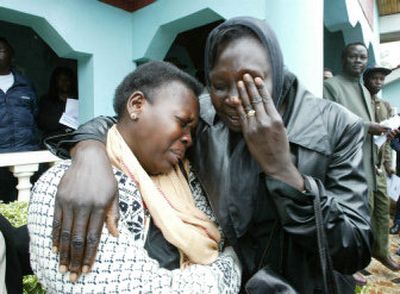Sudan leader’s death spurs rioting

KHARTOUM, Sudan – Grief-stricken supporters of a former Sudanese rebel leader tore through the capital in riots that left 36 people dead Monday, smashing cars and shops and angrily blaming the government for their hero’s death in a helicopter crash.
Despite doubts among the rioters, the southern rebel movement dismissed talk of a plot against Vice President John Garang and sought to keep alive the fragile north-south peace deal he championed for Sudan.
The 60-year-old Garang, who had been Sudan’s first vice president for just three weeks, died Saturday along with 13 other people when their helicopter crashed into a mountain in southern Sudan in bad weather.
“I feel like all my hopes are now broken,” said Ashraf Abdel-Hafez, sinking his head into his hands. Three weeks ago, the 26-year-old hotel employee beamed with excitement at the promise he saw in Garang’s triumphant return to Khartoum. On Monday, he cried.
His Sudan People’s Liberation Movement stressed that the crash was an accident, not foul play, and quickly named Garang’s longtime deputy, Salva Kiir Mayardit, to succeed him as head of the movement and as president of south Sudan, spokesman Yasser Arman told the Associated Press.
Kiir will also likely be first vice president, according to the January peace agreement that says whoever is Sudan People’s Liberation Movement leader will hold that position, said Kenyan Gen. Lazaro Sumbeiywo, a mediator in the peace talks.
On July 9, Garang was inaugurated into a national unity government that was seen as the key to bringing comprehensive peace to Sudan. He was working with the president and second vice president to form a Cabinet by Aug. 9.
“Losing the brother, the doctor, is a huge loss. He is a true peace partner and he has played a big role,” President Omar al-Bashir said.
Three days of national mourning have been declared.
President Bush called Garang a “visionary leader and peacemaker” and said the United States remained committed to Sudan’s peace process.
Despite the assurances of the rebel movement and the government, hordes of young men filled downtown Khartoum, smashing car windows and tearing off doors, setting fires, looting shops and in some cases chasing pedestrians away with stones. The government reported that 36 people were killed and approximately 300 were injured in the riots. No information was available on how many of those killed were security forces and protesters.
A 6 p.m. to 6 a.m. curfew was imposed, and by dusk only a few people walked the empty streets. Government and rebel leaders appealed for calm, saying the nation’s peace process would remain on track.
Garang was the dominant voice of the south since 1983. A colonel in Sudan’s army, he was sent south to quell a rebellion but deserted to form a rebel movement that fought the Muslim government in Kharoum for a share of wealth and political power for the mostly Christian and animist south. More than 2 million people died in the conflict.
The deal and Garang’s ascension to the national unity government were signs of hope for others who feel marginalized in Sudan. Many in the east and west, fighting their own battles with Khartoum, considered Garang an advocate.
The charismatic leader was welcomed by more than a million people from all regions of Sudan when he returned to Khartoum on July 8 for the first time since his rebellion began in 1983.